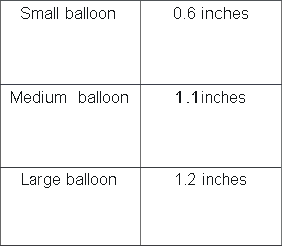Understanding the Magnitude of Static Electricity
| ✅ Paper Type: Free Essay | ✅ Subject: Sciences |
| ✅ Wordcount: 1606 words | ✅ Published: 12 Sep 2017 |
Abstract
The purpose of this experiment is to understand the magnitude of static electricity and the factors influencing it. The importance of this study can be linked to climate, technological advances, and improving existing inventions or creating new inventions. The fascination with static electricity motivated me to understand what static electricity is, in order to further my knowledge and flawlessly explain the science of lightning.
Static electricity is the imbalance of electric charge which produces a small spark, therefore on a much larger scale, lightning in a thunderstorm is the result of the separation of protons and electrons. For my experiment, I created an electroscope using a glass jar with a plastic lid, a paperclip holding two small pieces of aluminum foil and tape securing the paperclip. I used 3 balloons of different sizes, small, medium, and large and rubbed it on my hair to separate charges, then I brought the balloon closer to the electroscope and the aluminum foil then repelled from the other piece of aluminum; this successfully conveyed that there was a separation of charge on the balloon from rubbing it on my hair. I repeated this experiment with the next 2 balloons and recorded my results. To decrease the likelihood of failure, I did 2 more trials; the results I came across supported my original hypothesis which stated that the bigger the material, the greater amount of electric charge, and after conducting the experiment 2 more times with each different size of material, my hypothesis still was proved to be accurate. Upon proving the hypothesis to be true, I then concluded that the magnitude of lightning must have extreme strength considering the large scale damage it can do, and the fascination continued as I felt as though the science behind lightning was now between my very fingertips.
To conclude, my experiment has taught me about the science of static electricity, the different ways we can separate charges in order to induce a shock, and how it can be related and interconnected with climate. This field of study has extreme significance and I am confident that the use of static electricity will grow, such as the use of static electricity in printers and photocopiers has already been implemented. For the next experiment I conduct, I would like to test the different influences other factors have on static electricity, such as the type of materials tested, the effects of the environment where the experiment takes place, or the significance of climate regarding static electricity.
Introduction
I have always been fascinated with electric charge, static electricity, and the effects of friction. The fascination with science and its relationship to static electricity and climate leaves me wondering what causes static electricity, how it is produced, and what are the factors that create a higher magnitude of static electricity. The main reason I am motivated to do this experiment is due to the fact that the world is advancing technologically each and every day. In my opinion the incorporation of static electricity into common applications is a very important subject to study; especially considering the amazing capabilities, and future advancements, of printers, photocopiers. I have many un-answered questions about the science of static electricity and the various factors that influence it.
The topic of static electricity raises interesting points and thought provoking questions, I would like to answer a few such as; how does static electricity relate to lightning? What is the effect of size and temperature on static electricity? And, is static electricity necessary for life on Earth?
- The purpose of this experiment is to examine the difference in magnitude of static electricity, using several materials of different sizes. Testing the different materials will then lead me to understand the factors that may influence the strength of electric charges, and how it could relate to climate.
- Hypothesis: I think that the size of an object is ther essential factor affecting the magnitude of static electricity, that is, the bigger the material, the greater magnitude
Indicatevariables
Manipulated variable :Size of the material testing balloons
Responding variable: Amount of static electricity
Constants: The types of materials, number of times each balloon is rubbed, and the temperature in the room the experiment will be conducted in.
Research
Static electricity is an imbalance of electric charges, and is generated by the separation of positive charges and negative charges. Therefore, when two different materials are within contact, the electrons can move from one material to the next when then leaves a surplus of positive charge on the other material, this consequently creates static electricity. Static electricity may be produced by friction and create a spark; however friction does not create it, but rather the transfer of electrons will create the static charge.
All materials, people, and objects contain atoms. Atoms possess a nucleus which consist of protons and neutrons, whereas the electrons are outside of the nucleus. Objects and materials are usually neutrally charged as there is an equal number of protons and electronshowever if there is an imbalance between the electric charges induced by contact, static electricity will generate.
Static electricity can also be generated through various ways, such as when putting ceramics under pressure or heat. One can also separate charges by positioning a charged object near a neutral object. This results in the charges of the neutral object repelling the same polarity as the charged object while the charged object will be attracted to the opposite polarity, which then causes the neutral object to have an unequal amount of charge.
Discovering the different ways to separate charges increases my motivation to understand the factors that affect the magnitude of static electricity. The transfer of electrons onto a different material and having an imbalance between charges will result in static electricity, however I would like to understand the relationship between polarity and size. My entire experiment is based on the many factors that could possibly influence the degree of static electricity. I am using the factors that could possibly affect static electricity as my foundation because static electricity is vital to human existence, and important. .
Hypothesis
Based on my research, I think that the size of an object is the significant factor affecting the strength of static electricity, in other words, the larger the material, the greater the magnitude. Research that I have conducted has helped me discover the science behind lightning, which reenforces my hypothesis of larger materials or objects that hold electric charge having greater strength because of how strong lightning is. Lightning is essentially static electricity on a bigger scale.
Procedure
Materials
- Glass jar
- Plastic lid
- Tape
- Aluminum foil
- Paper clip
- Balloons
- Ruler
Variables
- Manipulated variable- For this experiment, the size of each balloon will be manipulated.
- Respondingvariable– The magnitude of static electricity observable from the foil repels.
Stepbystep
- Inflate 3 balloons of different sizes; small, medium, and large
- Straighten the paper clip out, then create a shape with a center circle with two hooks attached to it
- Make a small opening in the middle of the plastic lid
- Place the paper clip in the opening with the center circle sticking out from the top, and the hooks at the bottom, then secure it with tape
- Cut two small pieces of aluminum foil of equal size, then make a small hole in the end of each strip
- Attach the strips of foil onto the hooks of the paperclip
- Now we have an electroscope and it’s time for the experiment to be conducted, create a data chart to record trials and measurements
- Grab the small balloon, and rub it on your hair 10 times, then take the balloon and get close to the top of the electroscope, the foil should then move apart; this conveys that there is a separation of charges.
- Measure the distance between the aluminum foil in the data chart
- Repeat step 8 with the next two balloons and record the results to compare the strength of static electricity
- Complete 2 more trials for each size of the balloons
Results
Observations

|
Small balloon |
0.7 inches |
|
Medium balloon |
1inch |
|
Large balloon |
1.2 inches |


Conclusion
Based on the results of this experiment, the hypothesis that the bigger the material is, the stronger the magnitude, is proven to be true. The small balloon on each trial has the smallest distance between the 2 strips of aluminum foil, and the large balloon has the largest distance. This correlation supports my original chypothesis and can therefore expand my knowledge of static electricity and apply Q-:it to wider scales. This study has extreme significance as it can be applied to creating new inventions with the use of static electricity, explaining climate, and understanding the different strengths of static electricity and its uses. On a personal interest, I believe the fascination with this topic is because of how powerful lightning can be, and how it can be conducted from my very fingertips.
The purpose of this project for me is to understand the science behind lightning learned the details of static electricity, why we feel a shock when there is an imbalance of charges, and the different ways to separate charges. For next time, I would like to experiment with varying materials rather than different sizes, and possibly change small details such as, number of rubs per material, number of trials, and trying to experiment in different temperatures.
Bibliography
Hanania, Jordan, Kailyn Stenhouse, and Jason Donev. “Static electricity.” Static electricity-EnergyEducation.N.p., n.d. Web. 9 Jan. 2017.
“How does static electricity work?” Howdoesstaticelectricitywork?{Everyday
Mysteries: FunScienceFactsfrom theLibraryofCongress).N.p., n.d. Web. 10 Jan.
2017.
“What Is Static Electricity?” LiveScience.Purch, n.d. Web. 10 Jan. 2017.
Cite This Work
To export a reference to this article please select a referencing stye below:
Related Services
View allDMCA / Removal Request
If you are the original writer of this essay and no longer wish to have your work published on UKEssays.com then please click the following link to email our support team:
Request essay removal



